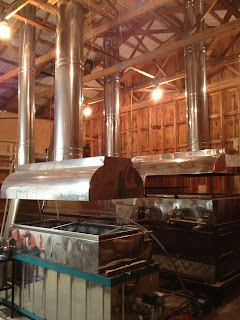After the Grain Farmers of Ontario March classic I met up with Steve Twynstra who owns a very impressive cash cropping business near Ailsa Craig, situated about 25 minutes drive North West of London Ontario. Steve's business revolves around soybeans, corn and wheat and is spread over quite a large area surrounding London.
I met Steve at the conference before I hired a car and headed out to meet him at the farm. The workshop and office where we met were immaculate as was every piece of machinery I could see. The tractors were polished clean, all the machinery goes through a very thorough process in the workshop through the winter period. Steve also had 3 lorry units that he uses to haul, grain and fertiliser at certain times of the year. The size of the equipment was very impressive as well. A cultivator, similar to a germinator, with tines and rollers with levelling bars was tucked away and was 50' wide (15.25m).
In the last couple of years Steve had put up some very impressive on farm round silo's to hold the crop grown on the farm. Steve has been using variable rate technology since the mid 1990's and has done a lot of research work on using yield maps to create the variable rate plans.
After a lovely dinner cooked by Mrs Twystra (Dianne), Steve and I headed out in the snow in the truck to a neighbours farm. Here the group meet up once a month to have a general agricultural discussion. The group started as a marketing group and over time it has morphed into more of a general discussion usually with external speakers in attendance. This is where I met up with Peter Johnson again and so we talked wheat for the next couple of hours. I also had a few slides about being a LEAF Demonstration farm so I showed those off as well.
The farm hosting the event also produced maple syrup form the maple trees on the farm. About 100 acres of trees are tapped each year to produce the sap. The sap only rises at certain times and needs a specific temperature pattern to get it going. A cold frosty night should be followed by a warmer day. The sap is collected and reduced down using wood fires. The final process uses gas heat so that more control of the temperature can be obtained. The native Indian population in Canada thought the first settlers how to do this using hollowed out trees filled with sap and then dropping hot fire stones in to remove the water and concentrate the syrup. The process in reduced by a value of 40. i.e. 40L of sap is required to make 1L of Maple Syrup!
The darkness of the syrup depicts the different amount of flavour. The darker the colour the more intense the taste. Different flavours occur during different times of the season, depending on how the sap rises. It was a fascinating end to another great day. The next I was on the road, getting up at 3.30 for the 7 hour, 400 mile drive East and then North to Ottawa, Canada's capital city, to meet up with my wife Andrea and daughter Jorja.





No comments:
Post a Comment